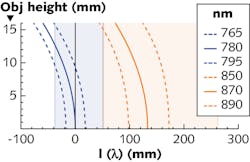Chromatic aberrations and dual wavelengths extend depth of field in iris recognition
Researchers at the National University of Ireland and FotoNation (both in Galway, Ireland) have developed an optical scheme that uses dual-wavelength illumination that introduces chromatic aberration in a singlet lens to double the depth of field (DOF)—compared to conventional single-wavelength-imaging lenses—for iris-recognition systems in smartphone cameras. Paraxial ray tracing was used to analytically determine the optimal lens parameters and the wavelengths were chosen from commercially available near-infrared (near-IR) LEDs.
Reverse ray-tracing through a plano-convex singlet lens (with two aspheric surfaces) from the detector to the object space shows that two different near-IR wavelengths that generate longitudinal chromatic aberration in the lens result in two separate points in object space, each with their own DOF. By choosing the correct aperture diameter, the DOF for both wavelengths meet with no gap between them. As the object distance is moved along the extended-DOF region in object space, the iris image remains in focus on the detector for at least one wavelength. The method allows extended DOF without the use of complex and computationally intensive focusing algorithms or zoom lens hardware. The lens design and chosen wavelengths can be altered to match the range of object distances depending on the application. Reference: N. M. Fitzgerald et al., Opt. Express, 25, 25, 31696–31707 (2017).
About the Author

Gail Overton
Senior Editor (2004-2020)
Gail has more than 30 years of engineering, marketing, product management, and editorial experience in the photonics and optical communications industry. Before joining the staff at Laser Focus World in 2004, she held many product management and product marketing roles in the fiber-optics industry, most notably at Hughes (El Segundo, CA), GTE Labs (Waltham, MA), Corning (Corning, NY), Photon Kinetics (Beaverton, OR), and Newport Corporation (Irvine, CA). During her marketing career, Gail published articles in WDM Solutions and Sensors magazine and traveled internationally to conduct product and sales training. Gail received her BS degree in physics, with an emphasis in optics, from San Diego State University in San Diego, CA in May 1986.
